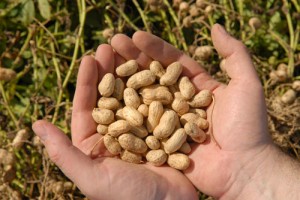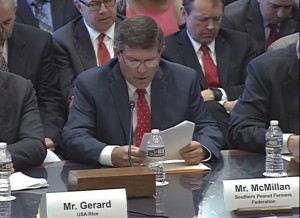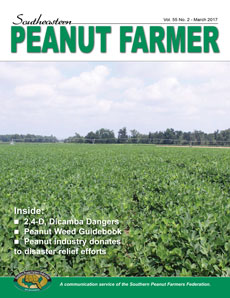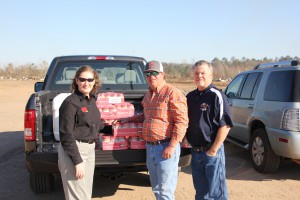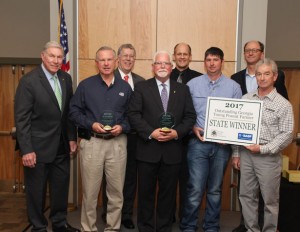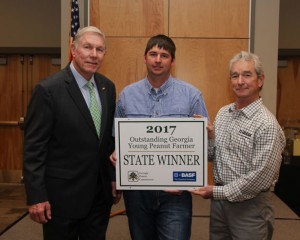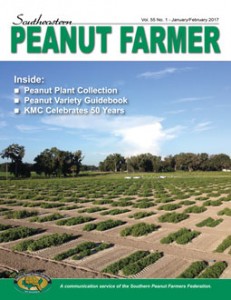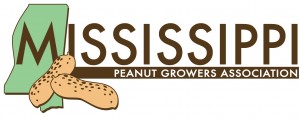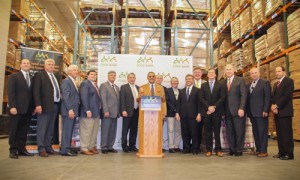
U.S. peanut industry representatives from the Southern Peanut Farmers Federation, American Peanut Shellers Association and National Peanut Buying Points Association join with U.S. Representative Sanford Bishop, D-Georgia, (center) to donate 30,000 jars of peanut butter to the Capital Area Food Bank in Washington, D.C. on National Ag Day, March 21, 2017.
The U.S. peanut industry donated more than 30,000 jars of peanut butter to Capital Area Food Bank in Washington, D.C. on National Ag Day, March 21, 2017. The Capital Area Food Bank is the largest organization in the Washington metro area working to solve hunger and its companion problems: chronic undernutrition, heart disease, and obesity. The donation was made possible by the partners of the Southern Peanut Farmers Federation, which includes Alabama Peanut Producers Association, Florida Peanut Producers Association, Georgia Peanut Commission and Mississippi Peanut Growers Association.
“We have found that peanut butter is one of the most requested items by food banks nationwide”, says Caleb Bristow, Alabama Peanut Producers Association executive director and Southern Peanut Farmers Federation member. “Not only is it a high-quality product, but it is full of nutrition and tastes great. On behalf of the Southern Peanut Farmer’s Federation, representing peanut farmers all across the Southeast, we are excited and proud to have this opportunity to provide this donation to the Capital Area Food Bank.”
Congressman Sanford D. Bishop, Jr., representative of Georgia’s second congressional district, joined the Federation members during the donation.
“I am honored to serve the top peanut producing congressional district in the country. Peanuts are a vital product of Middle and Southwest Georgia, and a key ingredient for an assortment of delicious and nutritious food products,” Congressman Bishop says. “I applaud the Southern Peanut Farmers Federation for their donation of 30,000+ jars of Peanut Proud peanut butter to the Capital Area Food Bank. This kind and generous donation will aid the Food Bank in their efforts to feed and provide for the surrounding community.”
By partnering with 444 community organizations in D.C., Maryland and Virginia, as well as delivering food directly into hard to reach areas, the CAFB is helping 540,000 people each year get access to good, healthy food.
“We applaud their focus on nutrition combined with educational support,” says Armond Morris, chairman of the Georgia Peanut Commission and Southern Peanut Farmers Federation member. “In the Washington, D.C., area 700,000 residents are at risk of hunger and we are proud as an industry to help support the food bank that is serving families in need in the area.”
Donations from organizations such as the Southern Peanut Farmers Federation are essential to the food bank’s operations, and allow the Capital Area Food Bank to distribute 46 million pounds of food to its network of partner nonprofits each year.
“Peanut butter is one of the hardest items to keep on our shelves because it’s protein-packed, kid-friendly, and in high demand from our partners,” said Jody Tick, chief operating officer at the food bank. “We’re thrilled for this donation, and 30,000 jars of peanut butter will go a long way towards helping children and families in our area get the food they need to live well”.
The donation was also made in celebration of National Peanut Month in March and National Ag Day. One serving of peanuts is a good source of protein, vitamin E, niacin, folate, phosphorus and magnesium. Peanuts are naturally cholesterol-free and low in saturated fat.
For additional details on the donation, visit the Southern Peanut Farmers Federation website at www.southernpeanutfarmers.org.

